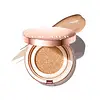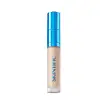What's inside
What's inside
 Key Ingredients
Key Ingredients

 Benefits
Benefits

 Concerns
Concerns

 Ingredients Side-by-side
Ingredients Side-by-side

Water
Skin ConditioningCI 77891
Cosmetic ColorantCyclopentasiloxane
EmollientTrimethylsiloxysilicate
EmollientDimethicone
EmollientMethyl Trimethicone
Skin ConditioningHexyldecyl Myristoyl Methylaminopropionate
EmollientButylene Glycol
HumectantCI 77492
Cosmetic ColorantGlycerin
HumectantAcrylates/Stearyl Acrylate/Dimethicone Methacrylate Copolymer
CI 77491
Cosmetic ColorantMagnesium Sulfate
Disteardimonium Hectorite
StabilisingAluminum Hydroxide
EmollientTriethoxycaprylylsilane
Synthetic Fluorphlogopite
1,2-Hexanediol
Skin ConditioningCI 77499
Cosmetic ColorantCaprylyl Glycol
EmollientDimethicone Crosspolymer
Emulsion StabilisingGlyceryl Caprylate
EmollientTrihydroxystearin
Skin ConditioningPalmitic Acid
EmollientEthylhexylglycerin
Skin ConditioningSorbitan Sesquioleate
EmulsifyingCentella Asiatica Extract
CleansingCholesterol
EmollientCeramide AP
Skin ConditioningCeramide NP
Skin ConditioningCeramide As
Skin ConditioningCeramide Ns
Skin ConditioningCeramide EOP
Skin ConditioningStearic Acid
CleansingMyristic Acid
CleansingTocopherol
AntioxidantTitanium Dioxide
Cosmetic ColorantZinc Oxide
Cosmetic ColorantHomosalate
Skin ConditioningHydrolyzed Hyaluronic Acid
HumectantHydrogenated Lecithin
EmulsifyingDipropylene Glycol
HumectantPentylene Glycol
Skin ConditioningGlyceryl Stearate
EmollientSucrose Distearate
EmollientWater, CI 77891, Cyclopentasiloxane, Trimethylsiloxysilicate, Dimethicone, Methyl Trimethicone, Hexyldecyl Myristoyl Methylaminopropionate, Butylene Glycol, CI 77492, Glycerin, Acrylates/Stearyl Acrylate/Dimethicone Methacrylate Copolymer, CI 77491, Magnesium Sulfate, Disteardimonium Hectorite, Aluminum Hydroxide, Triethoxycaprylylsilane, Synthetic Fluorphlogopite, 1,2-Hexanediol, CI 77499, Caprylyl Glycol, Dimethicone Crosspolymer, Glyceryl Caprylate, Trihydroxystearin, Palmitic Acid, Ethylhexylglycerin, Sorbitan Sesquioleate, Centella Asiatica Extract, Cholesterol, Ceramide AP, Ceramide NP, Ceramide As, Ceramide Ns, Ceramide EOP, Stearic Acid, Myristic Acid, Tocopherol, Titanium Dioxide, Zinc Oxide, Homosalate, Hydrolyzed Hyaluronic Acid, Hydrogenated Lecithin, Dipropylene Glycol, Pentylene Glycol, Glyceryl Stearate, Sucrose Distearate
Water
Skin ConditioningCyclopentasiloxane
EmollientButylene Glycol
HumectantCaprylyl Methicone
Skin ConditioningGlycerin
HumectantIsododecane
EmollientCaprylic/Capric Triglyceride
MaskingPhenyl Trimethicone
Skin ConditioningAcrylates/Polytrimethylsiloxymethacrylate Copolymer
Skin ConditioningPEG-10 Dimethicone
Skin ConditioningTrimethylsiloxysilicate
EmollientDimethicone
EmollientBoron Nitride
AbsorbentPolypropylsilsesquioxane
Squalane
EmollientPolyglyceryl-4 Isostearate
EmulsifyingCetyl PEG/PPG-10/1 Dimethicone
EmulsifyingSodium Chloride
MaskingDisodium Stearoyl Glutamate
CleansingAluminum Hydroxide
Emollient1,2-Hexanediol
Skin ConditioningHydroxyacetophenone
AntioxidantPalmitoyl Tripeptide-1
Skin ConditioningPalmitoyl Tetrapeptide-7
Skin ConditioningDisteardimonium Hectorite
StabilisingBisabolol
MaskingTocopheryl Acetate
AntioxidantTocopherol
AntioxidantDipotassium Glycyrrhizate
HumectantAscorbyl Palmitate
AntioxidantPolysilicone-11
Dimethicone/PEG-10/15 Crosspolymer
Pentaerythrityl Tetra-Di-T-Butyl Hydroxyhydrocinnamate
AntioxidantDisodium EDTA
Dipropylene Glycol
HumectantSodium Citrate
BufferingCarbomer
Emulsion StabilisingSodium Lactate
BufferingPolysorbate 20
EmulsifyingCI 77891
Cosmetic ColorantCI 77492
Cosmetic ColorantCI 77491
Cosmetic ColorantCI 77499
Cosmetic ColorantWater, Cyclopentasiloxane, Butylene Glycol, Caprylyl Methicone, Glycerin, Isododecane, Caprylic/Capric Triglyceride, Phenyl Trimethicone, Acrylates/Polytrimethylsiloxymethacrylate Copolymer, PEG-10 Dimethicone, Trimethylsiloxysilicate, Dimethicone, Boron Nitride, Polypropylsilsesquioxane, Squalane, Polyglyceryl-4 Isostearate, Cetyl PEG/PPG-10/1 Dimethicone, Sodium Chloride, Disodium Stearoyl Glutamate, Aluminum Hydroxide, 1,2-Hexanediol, Hydroxyacetophenone, Palmitoyl Tripeptide-1, Palmitoyl Tetrapeptide-7, Disteardimonium Hectorite, Bisabolol, Tocopheryl Acetate, Tocopherol, Dipotassium Glycyrrhizate, Ascorbyl Palmitate, Polysilicone-11, Dimethicone/PEG-10/15 Crosspolymer, Pentaerythrityl Tetra-Di-T-Butyl Hydroxyhydrocinnamate, Disodium EDTA, Dipropylene Glycol, Sodium Citrate, Carbomer, Sodium Lactate, Polysorbate 20, CI 77891, CI 77492, CI 77491, CI 77499
Ingredients Explained
These ingredients are found in both products.
Ingredients higher up in an ingredient list are typically present in a larger amount.
1,2-Hexanediol is a synthetic liquid and another multi-functional powerhouse.
It is a:
- Humectant, drawing moisture into the skin
- Emollient, helping to soften skin
- Solvent, dispersing and stabilizing formulas
- Preservative booster, enhancing the antimicrobial activity of other preservatives
Aluminum Hydroxide is a form of aluminum. It can be naturally found in nature as the mineral gibbsite. In cosmetics, Aluminum Hydroxide is used as a colorant, pH adjuster, and absorbent.
As a colorant, Aluminum Hydroxide may add opacity, or reduce the transparency. Aluminum hydroxide is contains both basic and acidic properties.
According to manufacturers, this ingredient is an emollient and humectant. This means it helps hydrate the skin.
In medicine, this ingredient is used to help relieve heartburn and help heal ulcers.
There is currently no credible scientific evidence linking aluminum hydroxide in cosmetics to increased cancer risk.
Major health organizations allow the use of aluminum hydroxide in personal care products and have not flagged it as a carcinogenic risk at typical usage levels.
Learn more about Aluminum HydroxideButylene Glycol (or BG) is used within cosmetic products for a few different reasons:
Overall, Butylene Glycol is a safe and well-rounded ingredient that works well with other ingredients.
Though this ingredient works well with most skin types, some people with sensitive skin may experience a reaction such as allergic rashes, closed comedones, or itchiness.
Learn more about Butylene GlycolCi 77491 is also hydrated iron III oxide. It's sole purpose is to give a red/pink hue to products.
Iron III oxides are classified as inorganic chemicals for coloring.
Synthetically created Ci 77491 is considered safer than those naturally found. This is because the synthetically created version may contain less impurities. Iron oxides are generally non-toxic and non-allergenic.
Learn more about CI 77491Ci 77492 is also hydrated iron III oxide. It's sole purpose is to give a yellow hue to products.
Iron III oxides are classified as inorganic chemicals for coloring.
Synthetically created Ci 77492 is considered safer than those naturally found. This is because the synthetically created version may contain less impurities. Iron oxides are generally non-toxic and non-allergenic.
Learn more about CI 77492Ci 77499 is also hydrated iron III oxide. It is created from mixing red and black iron oxides. This helps give shades of darkness to a product.
Iron III oxides are classified as inorganic chemicals for coloring.
Ci 77891 is a white pigment from Titanium dioxide. It is naturally found in minerals such as rutile and ilmenite.
It's main function is to add a white color to cosmetics. It can also be mixed with other colors to create different shades.
Ci 77891 is commonly found in sunscreens due to its ability to block UV rays.
Learn more about CI 77891Cyclopentasiloxane, or D5, is a silicone used to improve texture of products and trap moisture.
D5 is considered lightweight and volatile. Volatile means it evaporates quickly after application. Once evaporated, D5 leaves a thin barrier that helps keep skin hydrated.
It is also an emollient. Emollients help soften the skin and prevent water loss. Silicones create a silky texture in products. D5 helps other ingredients become more spreadable.
Studies show D5 is safe to use in skincare products. We recommend speaking with a skincare professional if you have concerns.
Learn more about CyclopentasiloxaneDimethicone is a type of synthetic silicone created from natural materials such as quartz.
What it does:
Dimethicone comes in different viscosities:
Depending on the viscosity, dimethicone has different properties.
Ingredients lists don't always show which type is used, so we recommend reaching out to the brand if you have questions about the viscosity.
This ingredient is unlikely to cause irritation because it does not get absorbed into skin. However, people with silicone allergies should be careful about using this ingredient.
Note: Dimethicone may contribute to pilling. This is because it is not oil or water soluble, so pilling may occur when layered with products. When mixed with heavy oils in a formula, the outcome is also quite greasy.
Learn more about DimethiconeDipropylene Glycol is a synthetically created humectant, stabilizer, and solvent.
This ingredient helps:
Dipropylene glycol is technically an alcohol, but it belongs to the glycol family (often considered part of the ‘good’ alcohols). This means it is hydrating and gentle on skin unlike drying solvent alcohols like denatured alcohol.
As a masking agent, Dipropylene Glycol can be used to cover the smell of other ingredients. However, it does not have a scent.
Studies show Dipropylene Glycol is considered safe to use in skincare.
Learn more about Dipropylene GlycolDisteardimonium Hectorite comes from the clay mineral named hectorite. It is used to add thickness to a product.
It can also help stabilize a product by helping to disperse other ingredients.
Hectorite is a rare, white clay mineral.
Learn more about Disteardimonium HectoriteGlycerin is already naturally found in your skin. It helps moisturize and protect your skin.
A study from 2016 found glycerin to be more effective as a humectant than AHAs and hyaluronic acid.
As a humectant, it helps the skin stay hydrated by pulling moisture to your skin. The low molecular weight of glycerin allows it to pull moisture into the deeper layers of your skin.
Hydrated skin improves your skin barrier; Your skin barrier helps protect against irritants and bacteria.
Glycerin has also been found to have antimicrobial and antiviral properties. Due to these properties, glycerin is often used in wound and burn treatments.
In cosmetics, glycerin is usually derived from plants such as soybean or palm. However, it can also be sourced from animals, such as tallow or animal fat.
This ingredient is organic, colorless, odorless, and non-toxic.
Glycerin is the name for this ingredient in American English. British English uses Glycerol/Glycerine.
Learn more about GlycerinTocopherol (also known as Vitamin E) is a common antioxidant used to help protect the skin from free-radicals and strengthen the skin barrier. It's also fat soluble - this means our skin is great at absorbing it.
Vitamin E also helps keep your natural skin lipids healthy. Your lipid skin barrier naturally consists of lipids, ceramides, and fatty acids. Vitamin E offers extra protection for your skin’s lipid barrier, keeping your skin healthy and nourished.
Another benefit is a bit of UV protection. Vitamin E helps reduce the damage caused by UVB rays. (It should not replace your sunscreen). Combining it with Vitamin C can decrease sunburned cells and hyperpigmentation after UV exposure.
You might have noticed Vitamin E + C often paired together. This is because it is great at stabilizing Vitamin C. Using the two together helps increase the effectiveness of both ingredients.
There are often claims that Vitamin E can reduce/prevent scarring, but these claims haven't been confirmed by scientific research.
Learn more about TocopherolThis silicone is an emollient. Emollients create a thin film on the skin to prevent moisture from escaping.
It is not soluble in water and helps increase water-resistance in products.
According to a manufacturer, it can blend seamlessly with silicone oils, such as Cyclopentasiloxane.
Learn more about TrimethylsiloxysilicateWater. It's the most common cosmetic ingredient of all. You'll usually see it at the top of ingredient lists, meaning that it makes up the largest part of the product.
So why is it so popular? Water most often acts as a solvent - this means that it helps dissolve other ingredients into the formulation.
You'll also recognize water as that liquid we all need to stay alive. If you see this, drink a glass of water. Stay hydrated!
Learn more about Water